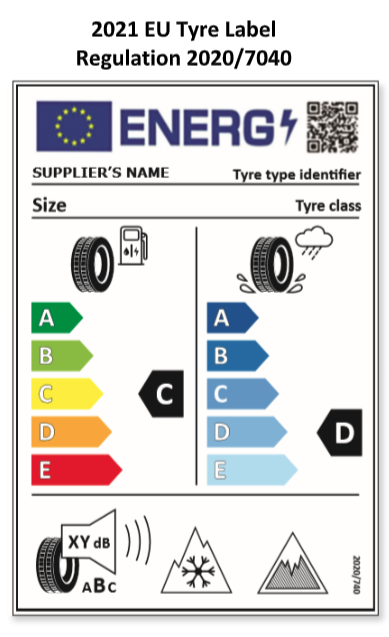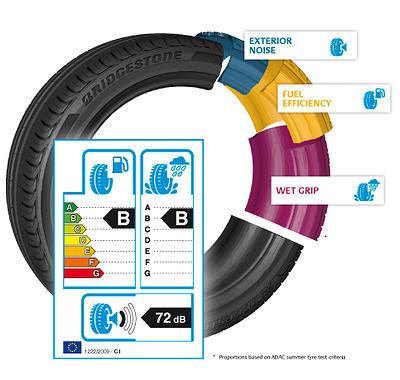Tyre Labels Explained (Updated 2021)
Since November 2012, tyre label regulations have been in force to help promote safer, more economical and more environmentally friendly road transport in Europe. The labels we’ve now become used to indicated tyre performance in three key areas: braking performance in wet conditions, exterior noise and fuel efficiency.
2021 Onwards: The New System for EU Tyre Labels
The European Commission launched a change-up of the tyre label system in May 2021, as part of its commitment to reduce carbon emissions. Helping consumers make better, safer and more eco-friendly choices was the driving force behind the new proposals – which in turn, should save the consumer money on fuel costs and tyre replacement charges.
The primary difference between this new and the old one is the inclusion of new categories and information alongside the current ones.

The new information that is now incorporated onto the tyre label is:
- Trade name of supplier
- A QR code to the EU product database
- Tyre item number
- The tyre size, speed index and the load index
- Ice and snow handle pictograms
- Updated code for rolling resistance, ranked A to E
- Updated decibel level, ranked A to C
The scoring system for rolling resistance will remain the same. There are also plans to include heavy-duty vehicles in the labelling system, as they were not previously. Also, the new tyre labels have been re-designed to improve clarity and visibility, and modelled on the EU energy labels that are found on common electrical appliances.
Previous Tyre Label Regulations (2012-2021)

The European Tyre Label is a good indicator of basic tyre performance and helps motorists easily compare the performance features of tyres.
When you first purchase a new tyre, the labelling should be affixed to the tyre itself in plain view. If it’s not, you will need to speak to the dealer about where you can locate this information.
The tyre labels in the past described three main features:
- Fuel efficiency rating: Tyres have a big impact on fuel consumption, and therefore influence how environmentally friendly they are. Each tyre is given a fuel efficiency rating which is ranked by a letter and associated colour; the lower the letter (e.g. A or B) the better the fuel efficiency, while letters in the red, such as F and G, mean poor fuel efficiency. By choosing a tyre with good fuel efficiency, your fuel will go further, saving you money on fuel bills, and reducing your carbon footprint.
- Noise rating: In our ever-busy world, noise pollution is an ever-present threat to the comfort of motorists, pedestrians and neighbourhoods. On the label, the tyre noise rating is described in decibels. Most people are unacquainted with decibels and their meaning, so the label also uses graphics to either show one, two or three black soundwaves. One soundwave signifies a quiet tyre, while three soundwaves indicates the tyre is above the European limit.
- Wet braking performance rating: Wet road conditions can present hazards for motorists, which is why it’s important to consider your vehicle’s braking performance in wet weather. On the EU tyre label, you will see the rating for wet braking, which is rated from A to F. The higher ratings, so A and B for example, will have a shorter braking distance in wet weather, making them the safer choice. Lower ratings mean the tyres have less grip in wet weather and will take longer to brake in these conditions. Always try and opt for a higher rating, but if you do have tyres with a lower rating, consider this fact when driving and stopping in rainy weather.
Mr Tyre is the region’s premier autocentre and tyre fitter. With 50 years’ experience, our professionals can supply a wide range of quality tyre brands to a variety of vehicle types – we also offer servicing, MOTs and repairs to keep your vehicle in top working order. Get in touch to learn more – alternatively, you can drop by one of our 35 branches across Central England. Our experts are happy to offer guidance on all of our products and services.


